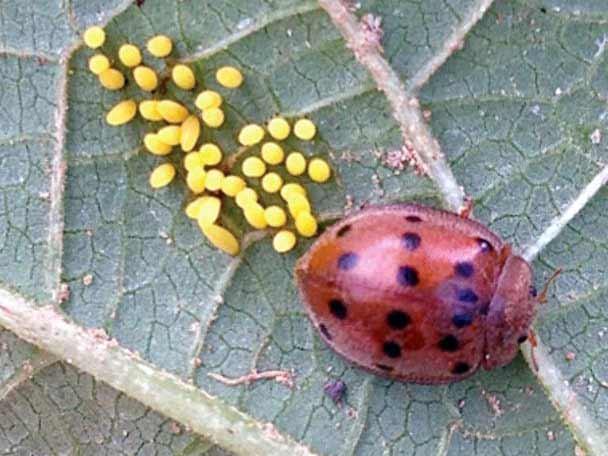Open-access article on Mexican bean beetles offers control tips

This is a Mexican bean beetle (Epilachna varivestis) adult with eggs. Credit: Entomological Society of America
“If you look through the literature on this pest, there are probably only 10 or so articles in the past 20 years, and nothing in terms of a profile-type article since the 1930s,” said Nottingham, a PhD student and graduate research assistant in the lab of Professor Tom Kuhar at Virginia Tech. “It was time to bring more attention to this beetle that is so significant in our growers' lives.”
A type of lady beetle originally known from high elevations of western Mexico and Central America, the Mexican bean beetle showed up in the western United States in the late 1800s in connection with the spreading cultivation of beans. The beetle favors wax beans and green snap beans in the genus Phaseolus. It will, however, eat all types of legumes, including alfalfa, and as settlers began transporting that forage plant to the East Coast as animal feed, they brought the beetles along.
After reviewing the available literature on the beetles, the researchers may have discovered a behavioral trait that can be used against them.
“If you look back in the literature, you'll see that if you shine a light on different sides of a bean plant, the beetles always abscond to the other side. That also explains why you find every life stage — eggs, larvae, pupae, and even the adults — almost always on the shaded side of the leaves,” Nottingham said.
After some thought about how they could manipulate light conditions, they decided to try metalized plastic mulch, which looks much like a sheet of aluminum foil with black backing. When placed on the soil around the plants, the mulch reflects light onto the bottoms of bean-plant leaves.
They contrasted small outdoor bean plots using the reflective mulch, black plastic sheeting, or plain soil, and observed beetle numbers, plant damage, and plant growth. Farm-scale research on the effect of reflective mulch remains to be conducted, but it looks good so far.
“We found significantly less of every life stage on plants in our plots with reflective mulch vs. black plastic and bare ground,” Nottingham said. “And the plants grew way better and had far less plant injury.”
Other options include mechanical removal, row covers, and the use of parasitoids.
###
The full article, “Natural History, Ecology, and Management of the Mexican Bean Beetle (Coleoptera: Coccinellidae) in the United States,” is available for free at http://dx.
The Journal of Integrated Pest Management is published by the Entomological Society of America, the largest organization in the world serving the professional and scientific needs of entomologists and people in related disciplines. Founded in 1889, ESA today has nearly 7,000 members affiliated with educational institutions, health agencies, private industry, and government. Members are researchers, teachers, extension service personnel, administrators, marketing representatives, research technicians, consultants, students, and hobbyists. For more information, visit http://www.
Media Contact
All latest news from the category: Agricultural and Forestry Science
Newest articles

A ‘language’ for ML models to predict nanopore properties
A large number of 2D materials like graphene can have nanopores – small holes formed by missing atoms through which foreign substances can pass. The properties of these nanopores dictate many…

Clinically validated, wearable ultrasound patch
… for continuous blood pressure monitoring. A team of researchers at the University of California San Diego has developed a new and improved wearable ultrasound patch for continuous and noninvasive…

A new puzzle piece for string theory research
Dr. Ksenia Fedosova from the Cluster of Excellence Mathematics Münster, along with an international research team, has proven a conjecture in string theory that physicists had proposed regarding certain equations….



